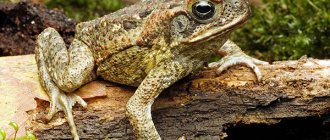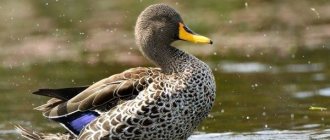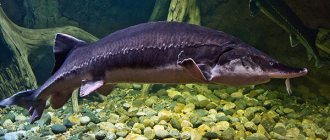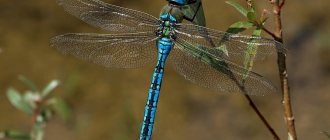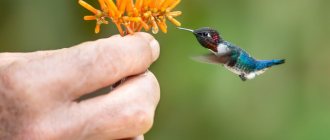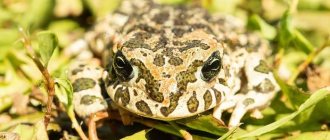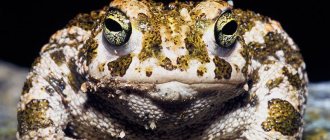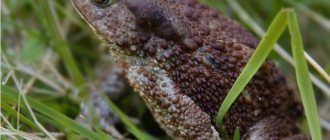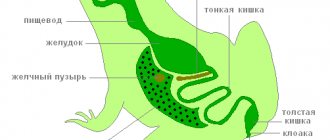The gray toad , or common toad , or cow toad (Bufo bufo) lives constantly on land, and enters water only to reproduce. It is the largest toad found in Europe. Easily tolerates loss of moisture, stores water in the skin during night “swims” in dew. The gray toad protects itself from enemies with poison, which acts as an emetic only when it finds itself in the enemy’s mouth. The gray toad is hunted by birds of prey, such as hedgehogs and rats.
Appearance
The gray toad is the largest toad in Europe. She has a wide, squat body and short toes on her paws. The eyes are orange with black horizontal pupils. Males do not have resonators. The skin is dry and lumpy with a small number of mucous glands, which allows the amphibian to conserve water and not dry out at a great distance from water bodies. It easily tolerates loss of moisture (it can lose up to 30% of its mass due to water evaporation without much harm). The toad stores water in its skin during nightly “swims,” when the toad washes itself in the dew. It protects itself from enemies with poison, which is secreted by parotids - glands located behind the eyes. The poison acts as an emetic and only when the toad is in the enemy's mouth.
Nutrition
Each amphibian has its own small habitat, which they thoroughly search for food. These amphibians feed on invertebrates: bugs, bugs, worms, caterpillars, even newborn lizards, snakes and mice, and their favorite dish is naked slugs. Prey can be seen at a distance of up to three meters. They hunt using their tongue, to which the prey sticks. If it is large, then the toad helps itself with the help of its front legs. Gray toads are very voracious, but even this fact does not allow them to eat dead animals.
Behavior of the common toad
Mainly nocturnal amphibian. During the day it hides under tree roots, stones, in grass, and rodent burrows. Most active in rainy weather, especially at night. The toad moves slowly (in steps) and jumps in case of danger. The most cold-resistant of toads. It enters hibernation at the end of September-October. It overwinters under fallen leaves, logs, in burrows and drainpipes, and sometimes buries itself in coastal mud. Wakes up at the end of March, when the temperature is not lower than +5°C. After hibernation, the common toad migrates to breeding grounds. In moments of danger, it puffs up and takes an aggressive pose.
Interesting experience
The gray toad, whose lifestyle is of great interest to scientists, was a participant in an interesting experiment. Its goal was to reveal aggression and hostility towards its relatives. The essence of the experience is quite simple. A leaf with honey was placed next to the toad. He attracted insects. A large accumulation of them aroused the interest of another toad. And she came to foreign territory. The owner of the area did not react to this at all. The two of them began to calmly enjoy their meal. And even when they hunted the same insect, and one stole the other’s prey, this did not in any way affect their external behavior. They continued to eat quietly. This experience suggests that these are very peaceful and non-conflict amphibians.
Reproduction
Males have thicker forepaws and shorter toes than females. During the breeding season, the membranes between the front toes of males become darker in color. The gray toad breeds in the same body of water throughout its life. Males wait for females in breeding areas. Each male has his own territory, which he protects from other contenders. One female lays up to 600-4000 eggs. The eggs are laid in the form of cords, wound around aquatic vegetation, snags, etc. A few days after spawning, adult amphibians leave the pond, but the largest male remains to guard the eggs.
Eggs and tadpoles
The spawning begins on a warm sunny day. Females are capable of producing from 600 to 4 thousand eggs. But out of such a large litter, usually 2-3 individuals survive to reproductive age. Caviar resembles cords that are wound around plants in ponds, on various branches, etc.
The incubation period takes 10 days. Tadpoles are found in large schools of their own kind, which increases their chance of survival. They are not afraid of everything, only strong splashes and vibrations of water, as well as the death of a fellow tribesman in the teeth of a predator. For the next 3 months, their life will depend only on the presence of mosquitoes and water temperature. The young toads will then leave their birthplace. Moreover, their size is no more than 1 cm.
Kursk region
Status: IV category. A species with a relatively low abundance, found in a limited area.
Spreading
Noted in the vicinity of the city. Dmitriev Lgovsky and Lgov, p. Mikhailovka, Zheleznogorsk district, in the Ivanovo forest dacha (Rylsky district), in the Glushkovsky, Sudzhansky and Oboyansky districts, in the vicinity of the village of Amon, Khomutovsky district and the village. Yastrebovka, Manturovsky district.
Number
No information on numbers.
Source: Red Book of Kursk Region. Rare and endangered animal species. Ed. Vlasov A.A., Bausov I.A., Vlasova O.P., Grechanichenko T.E., Korolkov A.K., Lada G.A., Mironov V.I. (2002) Central Black Earth Reserve
Natural enemies
She has plenty of enemies: birds of prey, snakes, hedgehogs, and rats. But the worst enemy is man. For many people, the gray toad is an ugly, useless and even harmful animal. But this opinion is far from reality. They, of course, do not shine with their beauty. They are poisonous, but this is only for protection purposes. After all, they simply physically cannot run away from their enemies. Because nature made them large and clumsy. Therefore, they compensated for their physical deficiencies with poisonous glands on their bodies. And from the point of view of benefits for humans, the toad is a very useful neighbor. It can eat up to 60% of pests in the garden. The gray toad is a very valuable and useful ally for humans, although not the most beautiful. But due to its nocturnal lifestyle, this is not scary.
Keeping in captivity.
Conditions of detention
To keep gray toads you need a horizontal type terrarium. A terrarium with a volume of 40 liters can contain 1-2 individuals. The top of the terrarium should be closed with a lid with ventilation holes. The soil is moist, loose earth with a layer of about 10 cm, covered with moss and fallen leaves. To keep the soil moist, the terrarium should be sprayed daily with water at room temperature using a spray bottle. Keeping temperature 18-25°C In the terrarium you need to place a cuvette with water and a shelter (humidity chamber). The terrarium should be illuminated during the day with a dim lamp with fluorescent lamps containing a minimum of ultraviolet radiation (UVB 2%) in their spectrum. In principle, adult toads can generally do without ultraviolet radiation since they are nocturnal animals, but for juveniles, which are also active during the day, a source of UVB is necessary to prevent rickets. Read more about ultraviolet sources HERE.
Feeding
The gray toad in the terrarium can be fed with crickets, marbled cockroaches, and other insects with soft covers. Sometimes you can give earthworms, slugs, bloodworms. Tadpoles are fed with sinking granulated fish food containing plant and animal components, scalded dandelion leaves, and lettuce.
Breeding
To stimulate reproduction, toads need overwintering for 2-4 weeks at a temperature of + 6-8°C. You can read about wintering of amphibians and reptiles HERE. After being brought out of winter, the animals are placed in an aquaterrarium. The water part of the aquaterrarium should have a smooth depth difference from 0 to 20 cm. Since the toad wraps egg cords around aquatic plants, their presence in the aquatic part of the terrarium is necessary. The water temperature should be 18-22°C. The water must be aerated and filtered without creating a strong current - a filter pump with an external sponge and a sprinkler flute at the outlet is suitable for this purpose. Producers are placed in a regular terrarium after they themselves come to land.
Aquaterrarium for spawning gray toads 1 - pump 2 - filter sponge 3 - sprinkler flute 4 - fluorescent lamp 5 - aquarium
Interesting facts about the animal
- Contrary to different opinions, you can pick up a cow shed. This does not cause warts. True, you can’t touch your eyes with your hands afterwards.
- In an indoor terrarium, life expectancy is up to 36 years, in natural conditions - a maximum of 15 years.
- The cow's skin is lumpy and drier than that of frogs.
- Many superstitious people are afraid of toads. This is due to the fact that the amphibian was used for their own purposes by evil sorcerers and witches.
- The creature cannot jump like a frog. It crawls slowly and swims poorly. This is due to the very short hind legs.
- Anyone who wants to have a toad at home will have to purchase a special terrarium and install it in a secluded corner of the apartment. The amphibian does not like loud sounds and direct sunlight.
- Amphibian venom is used in the pharmaceutical field.
- Gray toads can be seen in the Amphibian Research Unit. They are fed crickets, locusts and cockroaches. Once every 7 days, amphibians feast on small mice.
- The cowwoman's voice is different from the frog's. Before mating, the male hugs the female with his front paws and makes trills similar to grunting.
- The cowtail does not adapt well to living in anthropogenic landscapes.
Coitus - amplexus
Types of amplexus
Frogs lay eggs like fish, since the eggs (eggs) and embryos lack adaptations for development on land (anamnia). Various species of amphibians lay eggs in surprising places:
- into burrows whose slopes descend into the water. When a tadpole hatches, it rolls into the water, where its further development takes place;
- the female forms nests or lumps with mucus collected from her skin, then attaches the nest to the leaves that hang over the pond;
- some wrap each egg in a separate leaf of wood or reed hanging over the water;
- the female of the species Hylambates brevirostris generally carries eggs in her mouth . Males of the Darwinian rhinoderma species have special pouches in the throat, where they carry the eggs laid by the female;
- in arid areas, narrow-mouthed frogs live, which lay eggs in damp soil, where the tadpole then develops, and the formed amphibian crawls onto land;
- females of the genus pipa carry the eggs on themselves. After fertilization of the eggs, the male presses them with his abdomen into the back of the female, laying the eggs in rows. Eggs that stick to plants or to the bottom of a reservoir cannot develop and die. They survive only on the female's back. A couple of hours after laying, a porous gray mass forms on the female’s back, into which the eggs are buried, then the female molts;
- some types of females form ring shafts from their own mucus;
- in some species of frogs, a so-called brood pouch is formed in the folds of skin on the back, where the amphibian carries eggs;
- Some Australian species of frogs carry eggs and tadpoles in their stomachs. During the period of gestation in the stomach, the function of producing gastric juice is turned off with the help of prostaglandin.
During the entire period of gestation of the tadpoles, which lasts two months, the frog does not eat anything, but remains active.
During this period, she uses only internal reserves of glycogen and fat, which are stored in her liver. After the gestation process, the frog's liver decreases three times in size and there is no belly fat left under the skin. After laying eggs, most females leave their clutch, as well as spawning waters, and go to their usual habitats.
The females usually surround the eggs with a large layer of gelatinous substance . The egg shell plays a big role, since the egg is protected from drying out, from damage, and most importantly, it protects it from being eaten by predators.
After laying, after some time, the shell of the eggs swells and forms into a transparent gelatinous layer, inside of which the egg is visible. The upper half of the egg is dark, and the lower half, on the contrary, is light. The dark part heats up more, as it uses the sun's rays more efficiently. In many species of amphibians, lumps of eggs float to the surface of a reservoir, where the water is much warmer.
Low water temperature delays the development of the embryo. If the weather is warm, the egg divides many times and forms into a multicellular embryo. Two weeks later, a tadpole emerges from the egg - a frog larva.
The Republic of Mordovia
Status: III category. Rare view.
Spreading
On the territory of the Republic of Mordovia it is distributed sporadically, in some places the density is low.
Number
In some areas of the republic, it is a fairly common species with small populations. On the territory of the Mordovian Nature Reserve, the density is 1.5 ind./ha.
Source: Red Book of the Republic of Mordovia. Volume 2. Animals. Ed. IN AND. Astradamov (2005) Saransk. Mordovian book publishing house
Samara Region
Status: I category. The species is endangered.
Spreading
In the Samara region. (according to data for 1985-2007) the species is found in the Sviyago-Usinsk (Syzran and Shigonsky districts) landscape region.
Number
In recent years, only a few finds have been known. The habitat of this species in the vicinity. With. Khryashchevka in the Stavropol region, noted in 1951, was apparently destroyed as a result of the creation of the Kuibyshev reservoir. Within the mountains. Samara, where it was found until the 1980s, there are currently no reliable finds.
Source: Red Book of the Samara Region. Rare species of animals. Ed. Rosenberg G.S., Saksonov S.V. (2009) Togliatti: IEVB RAS; "Cassandra"
Fertilization or how frogs reproduce
Fertilization occurring externally
This type of fertilization occurs most often in frogs. The smaller male firmly clasps the female with his forepaws and fertilizes the eggs that the female lays. The male embraces the female in an amplexus position, which comes in three variations .
- Behind the front legs of the female, the male makes a girth (sharp-faced frogs)
- The male grasps the female in front of the hind limbs (scaphiopus, spadefoot spadefoot)
- The female is grabbed by the neck (poison dart frog).
Fertilization occurring internally
A few poison dart frogs (for example, Dendrobates granuliferus, Dendrobates auratus) are fertilized in a different way: the female and male turn their heads in opposite directions and connect their cloaca. In the same position, fertilization occurs in amphibians of the species Nectophrynoides, which first bear eggs and then tadpoles in utero until the process of metamorphosis is completed and give birth to fully formed frogs .
Male tailed frogs of the genus Ascaphus truei have a specific organ for reproduction.
Tambov Region
Status: III category. Rare view.
Spreading
In the Tambov region there is a section of the south-eastern border of the species' range. Found in the northern half of the region. Recorded in Morshansky, Pervomaisky, Sosnovsky, Pichaevsky, Michurinsky, Bondarsky, Tambovsky and Rasskazovsky districts within the Tsninsky and Ilovai-Voronezh forests.
Number
Rare everywhere. The relative abundance does not exceed 1.5 specimens per kilometer of route.
Source: Red Book of the Tambov Region: Animals. Ed. HE. Artaev, E.A. Ganzha, V.V. Glushkov, A.N. Gudina, A.V. Emelyanov, Yu.V. Zakharov, R.N. Ishin, E.V. Kalinkina (2012) Tambov: Yulis Publishing House LLC
Lipetsk region
Status: III category. Rare view.
Spreading
In the Lipetsk region it is found in the floodplain forests of the Voronezh River valley in the Kulikovo forest (Usmansky district), the Voronezh reserve (Usmansky district), and the Dobrovsky biological reserve (Dobrovsky district).
Number
Everywhere, except for spawning areas, only single individuals were recorded.
Source: Red Book of the Lipetsk Region. Volume 2. Animals. Ed. V.N. Alexandrov, M.V. Melnikov, V.S. Sarychev, M.N. Tsurikov, Yu.E. Shubina (2014) Lipetsk, Veda Society LLC
Myths and truth
There are many legends about toads, which are based on their ability to secrete poison. And this serves as confirmation that the potions that were brewed by witches, healers or sorcerers always contained part of a toad (its paw, for example). And that's why most people fear and kill toads. But this is far from justified violence. Toad venom, once on intact human skin, will not cause much harm. Only when it comes into contact with mucous membranes and damaged skin can it cause irritation, redness and slight inflammation. Therefore, under no circumstances should you rub your eyes or put your hands in your mouth after contact with a toad; you must first wash them. And then there will be no unpleasant incidents.
There is nothing superfluous in nature, and the gray toad is no exception.
